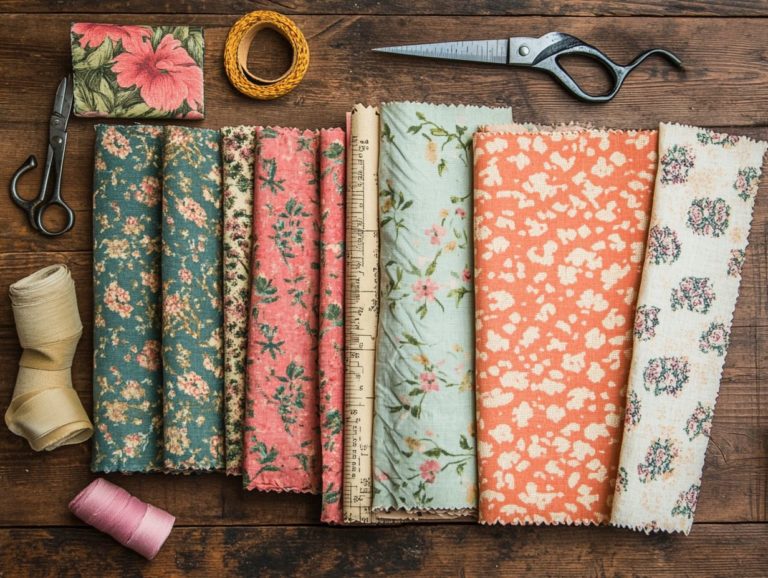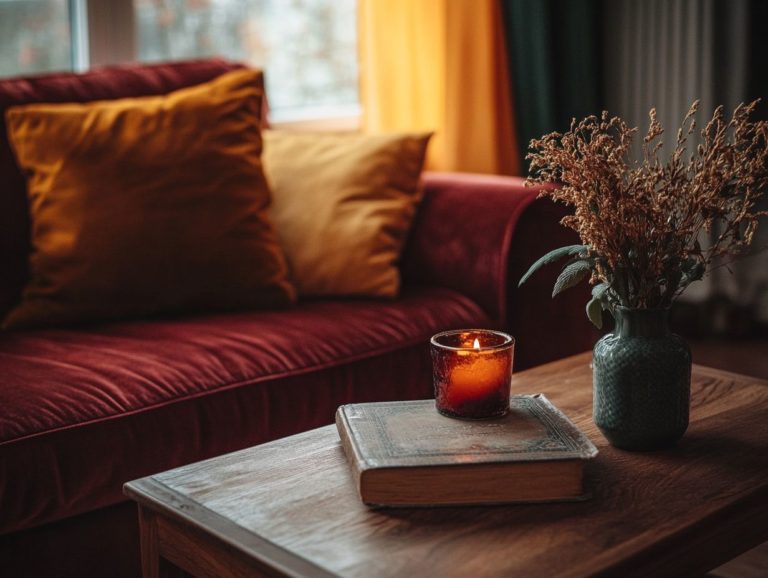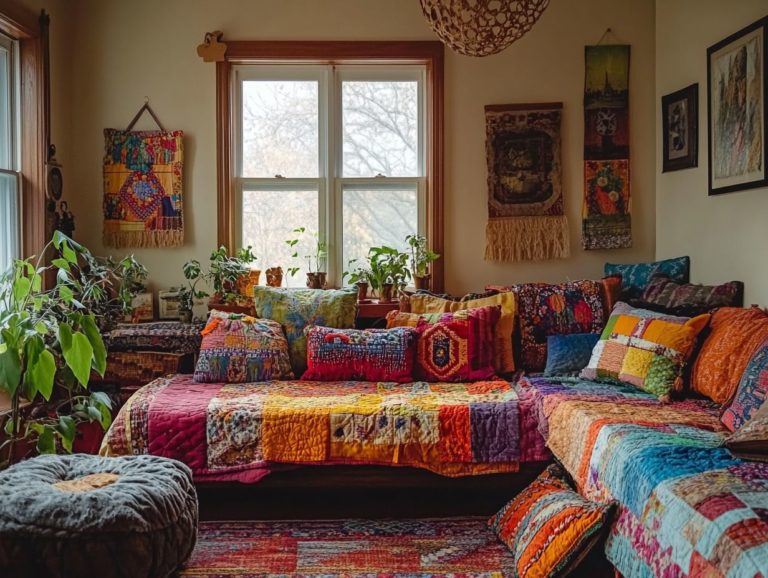Exploring Vintage Fabric Influences in Fashion
Vintage fabric has intricately woven itself into the tapestry of fashion history, shaping trends and styles through the ages.
From the sumptuous drape of silk to the opulent textures of velvet and lace, these materials carry stories that transcend time.
Get ready to explore how fabric has evolved in clothing over time! This article highlights beloved vintage fabrics and offers advice on how to seamlessly incorporate these timeless textiles into your modern wardrobe.
You’ll learn how embracing vintage fabrics can boost your commitment to sustainable fashion practices, ensuring your style is not only chic but also eco-conscious.
Contents
- Key Takeaways:
- The History of Vintage Fabric in Fashion
- Popular Vintage Fabrics and Their Characteristics
- Incorporate Vintage Fabric into Modern Fashion
- Why Sustainable Fashion Matters with Vintage Fabrics
- The Environmental Impact of Fast Fashion
- Benefits of Using Vintage Fabrics
- Frequently Asked Questions
- What is the definition of vintage fabric in fashion?
- Why is exploring vintage fabric influences important in fashion?
- What vintage fabrics are popular in fashion?
- How can vintage fabric be incorporated into modern fashion designs?
- What are the benefits of using vintage fabric in fashion?
- Where can one find vintage fabric for fashion purposes?
Key Takeaways:
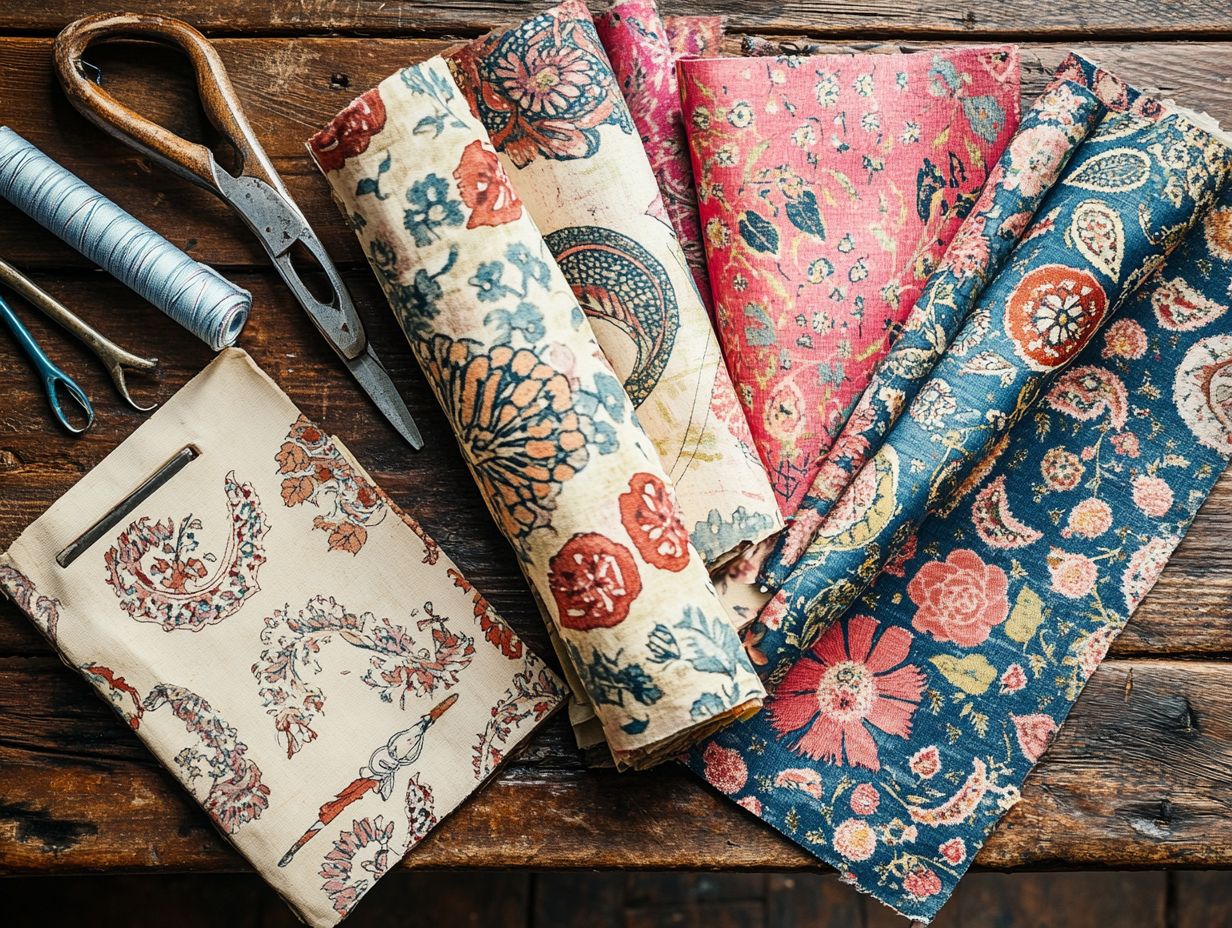
- Vintage fabrics have been a part of fashion history for centuries, evolving and adapting to different trends and styles.
- Silk, velvet, and lace are luxurious and delicate vintage fabrics, while cotton, wool, and linen are durable and versatile options.
- Mixing and matching vintage fabrics with modern pieces can create unique and timeless fashion looks, showcasing individuality and creativity.
The History of Vintage Fabric in Fashion
The history of vintage fabric in fashion is rich with cultural significance. These textiles show off artistry and craftsmanship passed down through generations.
Vintage fabrics reflect personal style and evoke nostalgia. They stand out against fast fashion, a quick production method that often sacrifices quality for speed, which often overlooks the quality of these textiles. Exploring the evolution of vintage fabric styles over decades can provide deeper insights into their unique charm.
Evolution of Fabric Use in Clothing
The evolution of fabric use in clothing reveals a captivating interplay of trends, artistry, and societal values. Vintage textiles have become increasingly coveted by discerning connoisseurs and collectors who appreciate their unique patterns and craftsmanship.
As garment technologies have advanced, traditional materials like cotton and wool often find themselves in the shadows of synthetic alternatives that boast durability and affordability. However, the swiftly shifting aesthetic preferences of modern consumers have sparked a renewed admiration for handmade fabrics, sourced sustainably and rich in history.
This cultural shift has rekindled interest in textures that evoke the charm of bygone eras, inspiring contemporary designers to draw from the intricacies of past styles, leading to more eco-friendly and authentic fashion choices.
Today s eco-conscious attitudes highlight not just creative expression but also the importance of ethical sourcing and material longevity, reflecting the values of a new generation of consumers who prioritize sustainability.
Popular Vintage Fabrics and Their Characteristics
Popular vintage fabrics like silk, velvet, and lace possess distinctive qualities that captivate both collectors and fashion aficionados. These materials embody a level of quality, elegance, and craftsmanship that is often lacking in today s contemporary options.
Silk, Velvet, and Lace

Silk, velvet, and lace emerge as treasured vintage fabrics, each boasting unique qualities that elevate their allure in contemporary fashion, making them sought-after by both designers and collectors.
Silk, with its luxurious sheen and silky smooth texture, has long graced royal garments and exquisite lingerie, exuding elegance. Velvet, characterized by its soft pile and rich depth, has become synonymous with opulent evening wear and lavish upholstery.
Lace, on the other hand, introduces a delicate intricacy, frequently adorning bridal designs and feminine accents, infusing a romantic essence into every piece.
In today’s fashion landscape, these fabrics are being reimagined through innovative techniques and sustainable sourcing methods, championing eco-friendly practices within the industry. As designers increasingly prioritize ethical considerations, the revival of these textiles reflects the impact of vintage textiles on eco-friendly design, striking a harmonious balance between honoring traditional craftsmanship and embracing modern values.
Cotton, Wool, and Linen
Cotton, wool, and linen are the quintessential vintage fabrics you should embrace for their durability and versatility. These fibers are steeped in rich historical significance that stretches back thousands of years. They beautifully contribute to a more sustainable wardrobe.
Cotton, derived from nature s very own plant, is breathable and soft. This makes it perfect for a variety of clothing items. Wool, harvested from sheep, envelops you in warmth and comfort, ideal for those chillier days. Linen, crafted from the flax plant, offers a lightweight and resilient option for your summer attire.
With the modern resurgence of vintage fashion, designers are increasingly weaving these natural materials into their collections. This appeals to consumers like you who prioritize ethical sourcing and environmental responsibility. These fabrics minimize waste and present timeless styles that align perfectly with eco-conscious values. To further appreciate these materials, consider exploring the textures of vintage fabrics.
Incorporate Vintage Fabric into Modern Fashion
Incorporate vintage fabric into your modern fashion to make a bold statement! This blend reflects your individuality while resonating with the values of your community. It creates a distinctive statement that honors both heritage and personal flair.
Tips for Mixing and Matching
- Mixing and matching vintage fabrics calls for careful selection, allowing you to express your creativity and showcase your individuality in a unique way.
- Master the principles of color matching. Choose a color palette that ties together both vintage and contemporary elements, ensuring they harmonize beautifully.
- Texture blending is crucial. Pair a soft vintage fabric with a sleek modern piece to create captivating contrasts that elevate your look.
Engaging with like-minded individuals who appreciate similar aesthetics cultivates a vibrant space for creativity. This leads to unique combinations that tell your own story and celebrate the craft of vintage fashion.
Why Sustainable Fashion Matters with Vintage Fabrics

Sustainable fashion and vintage fabrics are intricately linked. This connection celebrates unique artistry while championing eco-friendly consumer values. In today’s environmentally conscious market, this connection is becoming more significant, inviting you to embrace a style that resonates with both individuality and responsibility.
The Environmental Impact of Fast Fashion
The environmental impact of fast fashion is significant. It contributes to pollution and waste, emphasizing the need for vintage fashion as a sustainable choice that respects our planet and champions environmental conservation.
The fashion industry is responsible for about 10% of global carbon emissions. This staggering figure underscores its role in climate change. Every year, millions of tons of textiles end up in landfills, while fast fashion brands churn out garments at alarming rates, often chasing fleeting trends.
In contrast, when you choose vintage fashion, you promote resource conservation and minimize pollution. These items have already been produced, and their environmental costs have been absorbed. By opting for pre-loved pieces, you reduce your carbon footprint and revive the stories and craftsmanship embedded in each unique item. This fosters a deeper appreciation for sustainable practices.
Dive into the world of vintage fabrics today and discover styles that tell your story!
Benefits of Using Vintage Fabrics
Using vintage fabrics offers numerous benefits. You gain access to unique designs, exquisite craftsmanship, and a sustainable alternative to fast fashion.
This approach resonates with authenticity and individuality, creating a sense of community among enthusiasts. Incorporating these materials into your wardrobe champions a responsible approach to fashion while elevating your personal style with pieces that often come with a rich story, as seen in exploring the world of vintage fashion accessories.
Each vintage textile has a rich story behind it, showing the artistry of past artisans who devoted their talents to creating beautiful, enduring items. This appreciation for craftsmanship underscores the importance of longevity over disposability, fostering a culture that celebrates sustainability, as seen in the revival of vintage fabrics in contemporary decor.
Vintage fabrics also boast exceptional durability, far surpassing many mass-produced alternatives. This ensures they remain cherished staples in your wardrobe for years to come. By choosing these exceptional items, you contribute positively to the environment, supporting a fashion cycle that prioritizes quality and heritage over sheer volume. To learn more about these unique textiles, consider exploring the world of vintage cotton fabrics.
Frequently Asked Questions
What is the definition of vintage fabric in fashion?
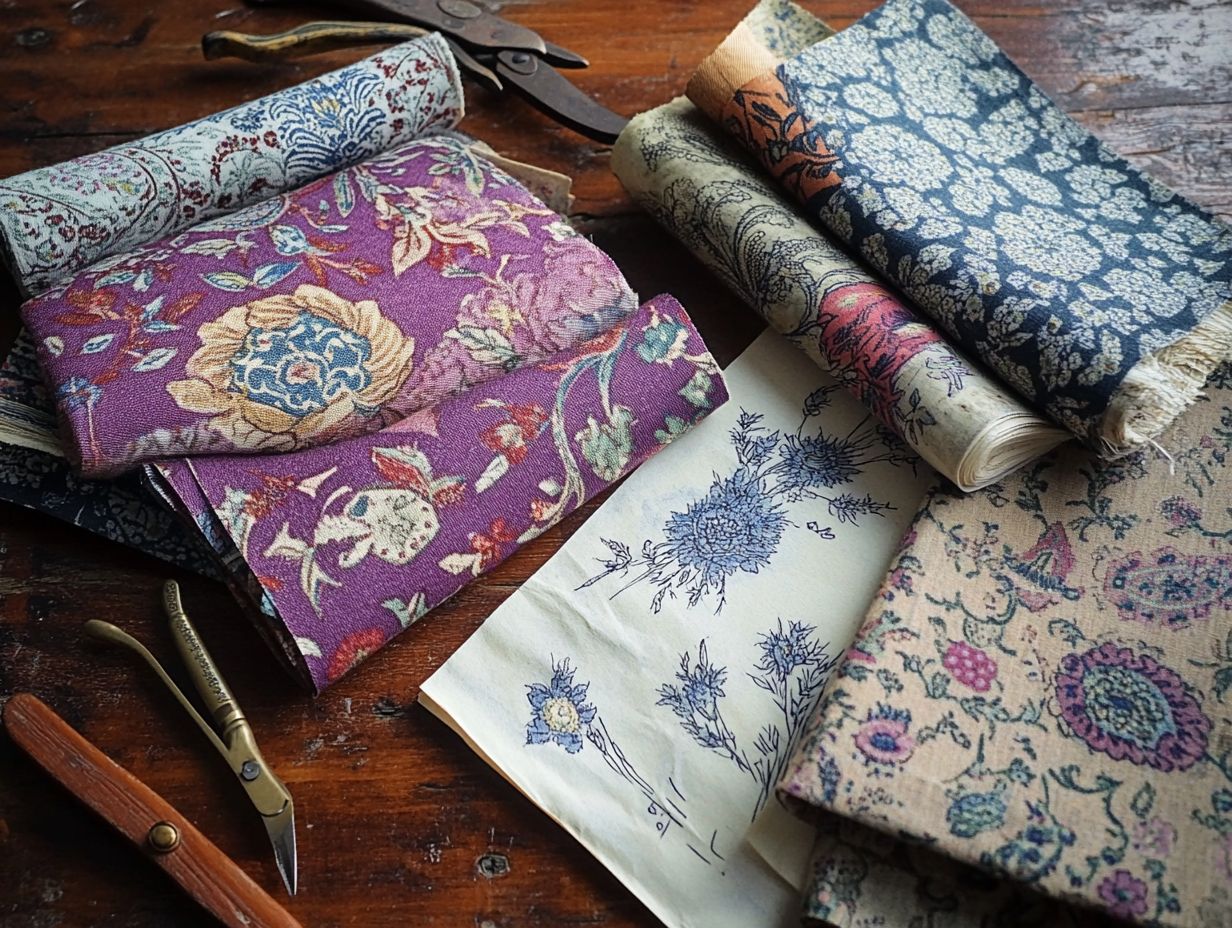
Vintage fabric refers to textile materials that were produced at least 20 years ago and have a significant influence on current fashion trends.
Why is exploring vintage fabric influences important in fashion?
Exploring vintage fabric influences in fashion allows designers to draw inspiration from past eras and incorporate unique elements into their designs. This creates a sense of nostalgia and uniqueness. Understanding the history of these fabrics enhances the value of textile design.
What vintage fabrics are popular in fashion?
Some popular vintage fabrics used in fashion include lace, silk, velvet, denim, and tweed. These fabrics are known for their durability, quality, and timeless appeal.
How can vintage fabric be incorporated into modern fashion designs?
Vintage fabric can be incorporated into modern fashion designs through various methods. These methods include using it as the main material, accent pieces, or even upcycling old garments into new creations.
What are the benefits of using vintage fabric in fashion?
Using vintage fabric in fashion adds a unique and nostalgic touch to a design. It also promotes sustainability by giving new life to old materials and reducing waste in the fashion industry.
Where can one find vintage fabric for fashion purposes?
Vintage fabric can be found in thrift stores, flea markets, and online marketplaces specializing in vintage clothing and materials. It can also be sourced from family heirlooms or repurposed from old garments.

